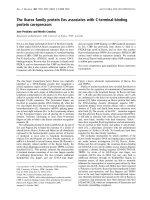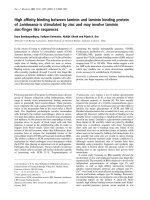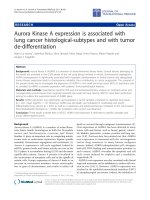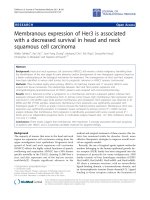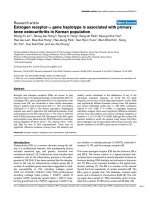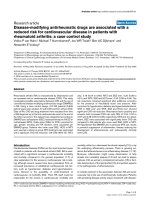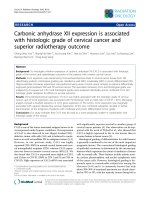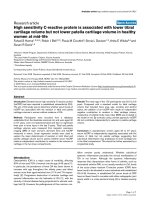Báo cáo y học: " High sensitivity C-reactive protein is associated with lower tibial cartilage volume but not lower patella cartilage volume in healthy women at mid-life" pdf
Bạn đang xem bản rút gọn của tài liệu. Xem và tải ngay bản đầy đủ của tài liệu tại đây (130.65 KB, 7 trang )
Open Access
Available online />Page 1 of 7
(page number not for citation purposes)
Vol 10 No 1
Research article
High sensitivity C-reactive protein is associated with lower tibial
cartilage volume but not lower patella cartilage volume in healthy
women at mid-life
Fahad S Hanna
1,2,3,4
*, Robin J Bell
1,2
*, Flavia M Cicuttini
3
, Sonia L Davison
1,2
, Anita E Wluka
3,4
and
Susan R Davis
1,2
1
Women's Health Program, Department of Medicine, Central and Eastern Clinical School, Monash University, Alfred Hospital, Prahran, Victoria
Australia
2
The Jean Hailes Foundation, Clayton, Victoria Australia
3
Department of Epidemiology and Preventive Medicine, Monash University, Prahran, Australia
4
Baker Heart Research Institute, AMREP Centre, Melbourne, Australia
* Contributed equally
Corresponding author: Susan R Davis,
Received: 3 Jan 2008 Revisions requested: 8 Feb 2008 Revisions received: 21 Feb 2008 Accepted: 29 Feb 2008 Published: 29 Feb 2008
Arthritis Research & Therapy 2008, 10:R27 (doi:10.1186/ar2380)
This article is online at: />© 2008 Hanna et al.; licensee BioMed Central Ltd.
This is an open access article distributed under the terms of the Creative Commons Attribution License ( />),
which permits unrestricted use, distribution, and reproduction in any medium, provided the original work is properly cited.
Abstract
Introduction Elevated serum high sensitivity C-reactive protein
(hsCRP) has been reported in established osteoarthritis (OA).
The aim of this study was to determine whether serum levels of
hsCRP are associated with the variation in tibial and patella
cartilage volumes in women without evidence of OA.
Methods Participants were recruited from a database
established from the Australian electoral roll, and were aged 40
to 67 years, were not hysterectomized and had no significant
knee pain or knee injury in the last 5 years. Tibial and patella
cartilage volumes were measured from magnetic resonance
imaging (MRI) of each woman's dominant knee and hsCRP
measured in serum. Linear regression models were used to
explore the major determinants of variation in both tibial and
patella cartilage volume and to assess whether serum hsCRP
made an independent contribution to variation in the volumes of
cartilage in the two knee compartments.
Results The mean age of the 176 participants was 52.3 ± 6.6
years. Compared with a standard model for tibial cartilage
volume that included bone area, age, smoking and alcohol
status, the addition of an hsCRP term made an independent
negative contribution to variation in tibial cartilage volume,
irrespective of whether body mass index (BMI) was included in
the model or not. By contrast, using a similar approach, hsCRP
did not contribute independently to variation in patella cartilage
volume.
Conclusion In asymptomatic women aged 40 to 67 years,
serum hsCRP is independently negatively associated with the
volume of tibial but not patella cartilage suggesting that
subclinical inflammation may predispose to knee cartilage loss
in the tibial compartment. This should be further assessed by a
longitudinal study.
Introduction
Osteoarthritis (OA) is a major cause of morbidity, affecting
60% of men and 70% of women over the age of 65 years [1].
In particular, the prevalence of knee OA has been shown to
increase with age throughout the elderly years and affect
women more than aged-matched men (11% and 7% respec-
tively) [2]. Progressive destruction of articular cartilage and
synovial inflammation are the hallmarks of OA [1], with the
severity of clinical disease being proportional to articular carti-
lage lost [3]. However the pathogenesis of this common con-
dition remains poorly understood. Whether subclinical
systemic inflammation precedes the clinical manifestation of
OA is not known. Although the systemic inflammatory
response that characterizes other forms of arthritis, such as
rheumatoid arthritis (RA), is not usually manifest in OA, levels
of the acute phase reactant C-reactive protein (CRP) have
been found to be elevated in some individuals with established
OA [4-6]. However, in established OA, serum levels of CRP
have not been found to correlate with either radiographic joint
space width in a cross-sectional study [4] or disease severity
[5].
Arthritis Research & Therapy Vol 10 No 1 Hanna et al.
Page 2 of 7
(page number not for citation purposes)
Magnetic resonance imaging (MRI) has good tissue contrast
and anatomical resolution [7], thus allowing a non-invasive
examination of the joint structure in pre-disease or early stage
OA. MRI can visualize joint structure directly [8,9] and has
been recognized as a valid, accurate and reproducible tool to
measure articular cartilage volume [9,10]. Loss of knee carti-
lage has been shown to be related to knee pain [11] and joint
replacement with more than 10% lost before any radiological
changes can be detected [12].
As the knee is one of the most common joints to be affected
by OA [1], and OA commonly occurs in women in late mid-life,
to further explore whether low grade systemic inflammation is
associated with characteristics of articular cartilage we have
examined the relationships between high sensitivity (hs)CRP
and tibial and patella cartilage volumes measured by MRI in
asymptomatic women at mid-life. As the evaluation of the
direct relationship between hsCRP and knee cartilage is
potentially complicated by the concurrent relationships
between CRP and increased body fat, notably intra-abdominal
fat [13,14], and body mass index and knee cartilage volume
[15], we have taken an analytical approach to establish the
independent effects of hsCRP on knee cartilage.
Methods
Participants were women recruited to a cross-sectional study
of the role of androgens in women using a database estab-
lished from the electoral roll in the southern Australian state of
Victoria between April 2002 and August 2003 [16]. The data-
base of eligible women was created using the following meth-
odology: women were recruited by telephone using a
database of individuals from household addresses selected at
random on a weekly basis from Australian electoral areas.
Starting addresses were selected at random from the electoral
roll for each of the sampling points. Interviews were conducted
in person on Saturdays and Sundays between 9.00 am and
4.00 pm. Eight interviews were conducted per sampling point.
Only one eligible person was recruited per household, and
people recruited to the sample tended to stay on the active
database for about 2 years. Women underwent telephone
screening and were excluded if they were pregnant or less
than 6 weeks post-partum, or had experienced any of the fol-
lowing in the preceding 3 months: an acute psychiatric illness;
acute renal, liver, cardiovascular disease or any other acute
major illness; gynecological surgery; active malignancy or can-
cer treatment, excluding non-melanotic skin cancer. All partic-
ipants provided a detailed medical history in response to
specific questioning and those with an active medical condi-
tion were not recruited.
Women from the original cross-sectional study were eligible
for this study if they were aged 40 to 67 years, had not under-
gone a hysterectomy and had agreed to be re-contacted for
further studies. As our intent was to investigate subjects with
no significant current or past knee disease, individuals were
excluded if they had had any of the following: a clinical diagno-
sis of knee OA as defined by American College of Rheumatol-
ogy criteria, knee pain lasting for > 24 h in the last 5 years, a
previous knee injury requiring non-weight bearing treatment
for > 24 h or surgery (including arthroscopy), or a history of
any form of arthritis diagnosed by a medical practitioner. A fur-
ther exclusion criterion was a contraindication to MRI including
pacemaker, metal sutures, presence of shrapnel or iron filings
in the eye, or claustrophobia. Of the 355 women who fulfilled
these criteria, 176 remained eligible after further exclusions
based on the above or the subject being unlikely to be availa-
ble to complete the longitudinal protocol of re-assessment at
2 years.
Each participant attended for a single morning fasting blood
test and measurement of height (cm) and weight (kg) 1 to 2
years (mean 1.53 years, standard deviation (SD) 0.24 years)
prior to their knee joint MRI. At this time each woman com-
pleted a questionnaire that provided information about smok-
ing and alcohol consumption. Fasting blood drawn at the time
of recruitment to the original cross-sectional study was stored
at -80°C until assayed.
The study was approved by the Southern Health Human
Research and Ethics Committee and the Monash University
Human Research and Ethics Committee, Clayton, Victoria,
Australia and all participants gave written informed consent.
All participants were identified by number, not by name, and
the study was conducted in accordance with the Declaration
of Helsinki principles.
Measurement of hsCRP
Measurement of hsCRP was performed using a particle
enhanced immunoturbidimetric assay performed on a Hitachi
917 analyzer (Boehringer Mannheim, Friedrich-Ebert-Str.
10068167 Mannheim, Germany). The assay range was 0.1 to
20 mg/l, with intra-assay coefficients of variation (CVs) of
1.34% at 0.55 mg/l and 0.28% at 12.36 mg/l, inter-assay CVs
of 5.7% at 0.52 mg/l and 2.51% at 10.98 mg/l and a detection
limit of 0.03 mg/l.
Measurement of tibial cartilage by MRI
Each woman underwent an MRI scan of the knee of her dom-
inant leg (the one with which she first stepped off) between
October 2003 and August 2004. Tibial and patella cartilage
volumes were determined by MRI image processing on an
independent workstation using the Osiris software as previ-
ously described [17,18]. Knees were imaged in the sagittal
plane on a 1.5-T whole body magnetic resonance unit (Philips,
Eindhoven, The Netherlands) using a commercial transmit-
receive extremity coil. The following sequence and parameters
were used: a T1-weighted fat-suppressed 3D gradient recall
acquisition in the steady state, flip angle 55 degrees, repetition
time 58 ms, echo time 12 ms, field of view 16 cm, 60 parti-
tions, 513 × 196 matrix, one acquisition time (11 min 56 s).
Available online />Page 3 of 7
(page number not for citation purposes)
Sagittal images were obtained at a partition thickness of 1.5
mm and an in-plane resolution of 0.31 × 0.83 mm (512 × 196
pixels). The image data were then transferred to a workstation.
The volumes of the medial and lateral tibial cartilage plates and
the patella were isolated from the total volume by manually
drawing disarticulation contours around the cartilage bounda-
ries on each section. These data were re-sampled by bilinear
and cubic interpolation (area of 312 and 312 μm and 1.5 mm
thickness, continuous sections) for the final three-dimensional
rendering. The volume of the particular cartilage plate was
determined by summing the pertinent voxels within the result-
ant binary volume. A trained researcher read each MRI. The
intra-observer CVs for the medial and lateral tibial and patella
cartilage volume measures were 3.4%, 2.0% and 2.1%,
respectively [17]. A similar method was used to measure
patella bone volume [19]. The intra-observer coefficient of var-
iation for patella bone volume measure was 2.2%. Tibial pla-
teau cross-sectional area was used as a measure of tibial bone
size. It was directly measured from images reformatted in the
axial plane using the Osiris software, as previously described
[17]. CVs for the medial and lateral tibial plateau areas were
2.3% and 2.4%, respectively [17]. Body mass index (BMI) was
calculated as weight (kg)/height (m
2
).
Sample size
The number of women eligible for recruitment to this study was
limited by the need for their participation in a previous study,
being in our desired age range, not having had a hysterectomy
and agreeing to be contacted about participation in future
studies. The initial number recruited for this study was 176,
which gave us a statistical power of 90% to show a correlation
as low as 0.25 between the various risk factors and knee car-
tilage volume (alpha error 0.05, two-sided significance), thus
explaining up to 6% of the variance of cartilage volume.
Statistical analysis
The analytical approach used in this analysis was linear regres-
sion with total tibial and patella cartilage volumes as the
dependent variables. All variables were continuous except for
smoking and alcohol use, which were dichotomous (smoking/
non-smoking, drinks alcohol/does not drink any alcohol). The
hsCRP data was log transformed to normalize the distribution
of data.
For the univariate analysis, F values are provided where F =
mean square (regression)/mean square (residual). In the mul-
tiple regression analysis ΔF is provided, where ΔF= {sum of
squares (regression)(variable in)-sum of squares (regression)
(variable out)}/mean square (residual) (variable in).
The r
2
value for each linear regression model was used as an
indicator of the proportion of variation in the dependent varia-
ble explained by the model. The p values provided in the tables
4 and 5 refer to the change (Δ) in the r
2
value when a new term
is added to the regression model. The variables considered for
inclusion in the models were factors known from previous anal-
yses to be important in the determination of cartilage volume
(such as bone area/volume [20] and factors known to be asso-
ciated with serum levels of hsCRP [21]). The order of both
adding and removing the natural log (ln) hsCRP and the BMI
terms to the linear regression model was deliberately chosen
to establish the independent contributions of these factors to
the variation in the cartilage volumes. A p value of less than
0.05 was considered to be statistically significant. All analyses
were performed using the SPSS statistical package (version
14.0; SPSS Inc., Chicago, IL, USA). Demographic character-
istics are presented as mean (SD) or as otherwise specified.
Results
The mean age of the 176 women included in the analysis was
52.3 (6.6) years. Other participant characteristics are listed in
Table 1.
Table 1
Characteristics of the study population
Characteristics (n = 176) Mean (SD or %)
Age (years) 52.3 (6.6)
Height (cm) 164 (6.5)
Weight (kg) 72.7(14.1)
Body mass index (kg/m
2
)27.1 (5.5)
Current smoker 21(11.9%
Currently consumes some alcohol 138 (78.9%)
Total tibial cartilage volume (cm
3
) 3.27 (0.55)
Total patella cartilage volume (cm
3
) 2.54 (0.55)
Median high sensitivity C-reactive protein (mg/l) 1.81 mg/l (range 0 to 43.9)
Arthritis Research & Therapy Vol 10 No 1 Hanna et al.
Page 4 of 7
(page number not for citation purposes)
The univariate results are presented in Tables 2 and 3. For tib-
ial cartilage volume, the variables of particular interest from the
univariate analysis included bone area, age and ln hsCRP. For
the patella cartilage volume, the variables of interest included
bone volume, age, BMI and ln hsCRP.
The r
2
values for factors potentially contributing to total tibial
cartilage and patella volumes are shown in Tables 4 and 5. For
total tibial cartilage, total bone area explained 14% of the var-
iation in volume. The addition of age increased the proportion
of the variation in cartilage volume explained to 21%. The fur-
ther addition of smoking and alcohol to this model did not sig-
nificantly increase the proportion of variation in total tibial
cartilage volume explained, however we retained these varia-
bles in the analysis to form our standard model against which
to test the addition of both BMI and ln hsCRP. There was no
significant additional benefit with the addition of BMI. How-
ever, the inclusion of the CRP term increased the proportion
of cartilage volume variation explained to 28%: this was a
highly statistically significant increase in the r
2
value, and this
was seen whether BMI was included in the model or not (Table
4).
For the patella, 27% of the variation in patella cartilage volume
was associated with patella bone volume. This was increased
significantly to 30% with the addition of age but was essen-
tially unchanged by the addition of the smoking and alcohol
terms, although again we retained these terms in our standard
model against which to test the effect of the addition of the
BMI and ln hsCRP terms. Addition of either BMI or ln hsCRP
separately increased the proportion of variation in patella
cartilage volume explained to 32% (the change did not reach
statistical significance at the 5% level in either case). Although
the addition of both the ln hsCRP and BMI terms increased the
r
2
value by 2%, again the change did not reach statistical sig-
nificance at the 5% level (Table 5).
Discussion
The principal finding of this study was that in women at mid-
life, the level of hsCRP in serum made a significant independ-
ent contribution to the variation in the volume of total tibial car-
tilage measured approximately 12 to 18 months later. This
observation was true whether or not the analysis was control-
led for BMI. This observation did not hold true for the patella
compartment. Although BMI is a major determinant of CRP
[21], our analysis indicates that the impact of hsCRP is not
purely mediated through BMI.
While increased hsCRP has been reported in the early phases
of OA [22], this study provides the first evidence of an inde-
pendent relationship between hsCRP and tibial cartilage vol-
ume in asymptomatic individuals. Although OA is not
considered a classical inflammatory arthropathy, it is charac-
terized by intra-articular inflammation manifest as synovitis. In
this study we were not able to assess synovial effusion or
thickness from the MRI. However, recent studies have shown
a significant relationship between hsCRP levels and the
degree of synovial inflammatory infiltration in OA [23] and RA
[24].
CRP is an acute-phase protein that is produced in large
amounts by hepatocytes, upon stimulation by the cytokines
interleukin (IL)6, tumor necrosis factor α (TNFα) and IL1, dur-
ing an acute-phase response. Recent studies consistently
indicate that both TNFα and IL1 play a key role in cartilage
destruction in OA [25,26]. Although OA disease activity
appears to be limited to involved joints, release of cytokines
into the systemic circulation during the subclinical phase of
OA may explain the association we have seen between
hsCRP and tibial cartilage volume. The role of CRP in OA may
be complex, possibly involving specific haplotypes of the CRP
gene [27]. The relationship between CRP levels and BMI may
also be complex and involve modulation of CRP gene expres-
sion within adipose tissue [28].
Why the relationship with hsCRP was seen in the tibial com-
partment but not the patella compartment is unclear. However,
we have previously reported a lack of association between
patella and tibial cartilage loss over 2 years, suggesting that
pathogenetic mechanisms for OA in the patellofemoral and
Table 2
Univariate results of tibial cartilage volume (mm
3
)
F Significance of F
Bone area 28.81 < 0.001
Age 10.23 0.002
Smoking 1.32 0.25
Alcohol 2.00 0.16
BMI 0.49 0.49
ln hsCRP 12.87 < 0.001
F = the regression mean square divided by the residual mean square.
BMI, body mass index; ln hsCRP, natural log high sensitivity C-
reactive protein.
Table 3
Univariate results of patella cartilage volume (mm
3
)
F Significance of F
Bone volume 62.739 < 0.001
Age 5.04 0.026
Smoking 0.52 0.47
Alcohol 1.75 0.19
BMI 7.73 0.006
ln hsCRP 7.04 0.009
F = The regression mean square divided by the residual mean
square. BMI, body mass index; ln hsCRP, natural log high sensitivity
C-reactive protein.
Available online />Page 5 of 7
(page number not for citation purposes)
tibiofemoral joint may differ [19]. The assessment of the pres-
ence/absence of cartilage defects provides another method of
assessing cartilage health. In our study, the independent con-
tribution seen by hsCRP to variation in tibial cartilage volume
was not seen between hsCRP and the presence of cartilage
defects in the tibiofemoral compartment (data not shown). Our
findings that age and bone size influence knee cartilage vol-
ume corroborate previous findings [29].
Strengths of our study include the community-based recruit-
ment of asymptomatic women, the relatively large number of
study participants, and measurement of CRP by a highly sen-
sitive assay. A potential limitation of this study is that hsCRP
was only measured on one occasion. Although serial sampling
of CRP would have been optimal, it would not have been fea-
sible as many of the women in rural areas had to travel consid-
erable distances for blood sampling. To limit the possibility
that CRP levels may have been affected by intercurrent illness,
women were asked not to attend for their blood test on a day
they were not well. Another limitation to our study is that the
cross-sectional design does not provide information regarding
the usefulness of hsCRP in predicting cartilage loss. However,
re-assessment of our study population after 2 years will pro-
vide data for the predictive value of hsCRP for tibial cartilage
loss.
Table 4
Total tibial cartilage volume r
2
values and p values for Δr
2
for different linear regression models
Model for total tibial cartilage
volume
r
2
p Value for Δ r
2
compared with the
specified model
ΔF with addition to the model (p value for ΔF is the same as for
Δr
2
)
Bone area only (+) 0.14 < 0.001 N/A
Bone area (+) age (-) 0.21 < 0.001 compared with bone area
only
14.84
Bone area (+) age (-) smoking,
alcohol
0.22 0.43 compared with bone area
and age
0.86
Bone area (+) age (-) smoking,
alcohol, BMI
0.22 0.53 compared with bone area,
age, smoking and alcohol
0.39
Bone area (+) age (-) smoking,
alcohol, ln hsCRP (-)
0.28 < 0.001 compared with bone
area, age, smoking, alcohol
13.15
Bone area (+) age (-) smoking,
alcohol, BMI ln hsCRP(-)
0.28 < 0.001 compared with bone area
age smoking alcohol
7.23 (both variables added together); if BMI added first, ΔF =
0.43 (p for ΔF = 0.51) followed by lnCRP ΔF = 13.99, (p for ΔF
< 0.001); if ln CRP added first, ΔF = 13.15, (p for ΔF < 0.001)
followed by BMI ΔF = 1.28, (p for ΔF = 0.26)
Parenthesis indicate the sign of regression coefficients statistically significant at the 5% level. BMI, body mass index (kg/m
2
); ln hsCRP, natural log
high sensitivity C-reactive protein.
Table 5
Patella cartilage volume r
2
values and p values for Δ r
2
for different linear regression models
Model for total patella cartilage
volume
r
2
p Value for delta r
2
compared with
the specified model
ΔF with addition to the model (p value for ΔF as for Δr
2
)
Bone volume only (+) 0.27 < 0.001 N/A
Bone volume (+) age (-) 0.30 0.003 compared with bone
volume only
8.93
Bone volume (+) age (-) smoking,
alcohol
0.31 p = 0.65 compared with bone
volume and age
0.43
Bone volume (+) age (-) smoking,
alcohol, BMI
0.32 p = 0.06 compared with bone
volume, age, smoking and alcohol
3.54
Bone area (+) age (-), smoking,
alcohol, ln hsCRP
0.32 p = 0.19 compared with bone
volume, age, smoking, alcohol
1.78
Bone area (+) age (-) smoking,
alcohol, BMI ln hsCRP
0.33 p = 0.15 compared with bone
volume age smoking alcohol
1.92 (both variables added together); if BMI added first, ΔF =
3.54, (p for ΔF = 0.06) followed by lnCRP ΔF = 0.31, (p for ΔF =
0.58); if ln CRP added first, ΔF = 1.78, (p for Δ= F 0.19)
followed by BMI ΔF = 2.05, (p for ΔF = 0.15).
Parenthesis indicate the sign of regression co-efficients statistically significant at the 5% level. BMI, body mass index (kg/m
2
); ln hsCRP, natural
log high sensitivity C-reactive protein.
Arthritis Research & Therapy Vol 10 No 1 Hanna et al.
Page 6 of 7
(page number not for citation purposes)
Conclusion
That hsCRP measured several months prior to MRI scanning
of the knee was significantly associated with less tibial carti-
lage volume suggests the possibility that the presence of sub-
clinical systemic inflammation has a role in the early stages of
the disease process that precedes symptomatic OA. How-
ever, the present report was a cross-sectional study and none
of the women in this study had clinical evidence of OA. None-
theless, our findings indicate that assessing whether inflam-
mation precedes clinical OA merits specific investigation. If
activation of inflammation is found to have a pathogenic role in
OA development this could have implications as a target for
preventative therapy.
List of abbreviations
BMI = body mass index; CRP = C-reactive protein; CV = coef-
ficient of variation; hsCRP = high sensitivity CRP; IL = inter-
leukin; ln = natural log; OA = osteoarthritis; RA = rheumatoid
arthritis; SD = standard deviation; TNFα = tumor necrosis fac-
tor α.
Competing interests
The authors declare that they have no competing interests.
Authors' contributions
FH was responsible for data collection and analysis and inter-
pretation of the data. RB was responsible for analysis and
interpretation of the data. AW performed data analysis. FC and
SDavis were responsible for study design and data analysis
and interpretation and SDavison reviewed the final draft. All
authors prepared, read and approved the final manuscript.
Acknowledgements
This research was funded by the National Health and Medical Research
Council of Australia, grant numbers 219279, 284484 and 334267. We
appreciate the assistance of Roy Morgan Research Australia in the con-
duct of this research.
References
1. Goldring MB: Update on the biology of the chondrocyte and
new approaches to treating cartilage diseases. Best Pract Res
Clin Rheumatol 2006, 20:1003-1025.
2. Felson DT, Naimark A, Anderson J, Kazis L, Castelli W, Meenan
RF: The prevalence of knee osteoarthritis in the elderly. The
Framingham Osteoarthritis Study. Arthritis Rheum 1987,
30:914-918.
3. Sipe JD: Acute-phase proteins in osteoarthritis. Semin Arthritis
Rheum 1995, 25:75-86.
4. Conrozier T, Carlier MC, Mathieu P, Colson F, Debard AL, Richard
S, Favret H, Bienvenu J, Vignon E: Serum levels of YKL-40 and
C reactive protein in patients with hip osteoarthritis and
healthy subjects: a cross sectional study. Ann Rheum Dis
2000, 59:828-831.
5. Sturmer T, Brenner H, Koenig W, Gunther KP: Severity and
extent of osteoarthritis and low grade systemic inflammation
as assessed by high sensitivity C reactive protein. Ann Rheum
Dis 2004, 63:200-205.
6. Punzi L, Oliviero F, Ramonda R, Sfriso P, Todesco S: Laboratory
findings in osteoarthritis. Semin Arthritis Rheum 2005,
34:58-61.
7. Peterfy CG: MR imaging. Baillieres Clin Rheumatol 1996,
10:635-678.
8. Eckstein F, Charles HC, Buck RJ, Kraus VB, Remmers AE, Hudel-
maier M, Wirth W, Evelhoch JL: Accuracy and precision of quan-
titative assessment of cartilage morphology by magnetic
resonance imaging at 3.0T. Arthritis Rheum 2005,
52:3132-3136.
9. Wluka AE, Stuckey S, Snaddon J, Cicuttini FM: The determinants
of change in tibial cartilage volume in osteoarthritic knees.
Arthritis Rheum 2002, 46:2065-2072.
10. Jones G, Glisson M, Hynes K, Cicuttini F: Sex and site differ-
ences in cartilage development: a possible explanation for
variations in knee osteoarthritis in later life. Arthritis Rheum
2000, 43:2543-2549.
11. Jones G, Ding C, ScotT F, Glisson M, Cicuttini F: Early radio-
graphic osteoarthritis is associated with substantial changes
in cartilage volume and tibial bone surface area. Osteoarthritis
Cartilage
2004, 12:169-174.
12. Altman R, Asch E, Bloch D, Bole G, Borenstein D, Brandt K,
Christy W, Cooke TD, Greenwald R, Hochberg M: Development
of criteria for the classification and reporting of osteoarthritis.
Classification of osteoarthritis of the knee. Diagnostic and
Therapeutic Criteria Committee of the American Rheumatism
Association. Arthritis Rheum 1986, 29:1039-1049.
13. Yudkin J, Stehouwer C, Emeis J, Coppack S: C-reactive protein
in healthy subjects: associations with obesity, insulin resist-
ance, and endothelial dysfunction: a potential role for
cytokines originating from adipose tissue? Arterioscler
Thromb Vasc Biol 1999, 19:972-978.
14. Davison S, Davis S: New markers for cardiovascular disease
risk in women: impact of endogenous estrogen status and
exogenous postmenopausal hormone therapy. J Clin Endocri-
nol Metab 2003, 88:2470-2478.
15. Punzi L, Ramonda R, Oliviero F, Sfriso P, Mussap M, Plebani M,
Podswiadek M, Todesco S: Value of C reactive protein in the
assessment of erosive osteoarthritis of the hand. Ann Rheum
Dis 2005, 64:955-957.
16. Davison SL, Bell R, Donath S, Montalto J, Davis SR: Androgen
levels in adult females: changes with age, menopause and
oophorectomy. J Clin Endocrinol Metab 2005, 90:3847.
17. Wluka A, Stuckey S, Snaddon J, Cicuttini F: The determinants of
change in tibial cartilage volume in osteoarthritic knees.
Arthritis Rheum 2002, 46:2065-2072.
18. Wluka AE, Wolfe R, Davis SR, Stuckey S, Cicuttini F: Tibial carti-
lage volume change in healthy postmenopausal women: a
longitudinal study. Ann Rheum Dis 2004, 63:444.
19. Hanna F, Wluka AE, Ebeling PR, O'Sullivan R, Davis SR, Cicuttini
FM: Determinants of change in patella cartilage volume in
healthy subjects. J Rheumatol 2006, 33:1658-1661.
20. Cicuttini F, Wluka A, Wolfe R, Forbes A: Comparison of cartilage
volume and radiological assessment of the tibiofemoral joint.
Arthritis Rheum 2003, 48:682-688.
21. Ridker PM, Buring JE, Cook NR, Rifai N: C-reactive protein, the
metabolic syndrome, and risk of incident cardiovascular
events: an 8-year follow-up of 14 719 initially healthy American
women. Circulation 2003, 107:391-397.
22. Saxne T, Lindell M, Mansson B, Petersson IF, Heinegard D:
Inflammation is a feature of the disease process in early knee
joint osteoarthritis. Rheumatology (Oxford) 2003, 42:903-904.
23. Pearle AD, Scanzello CR, George S, Mandl LA, DiCarlo EF, Peter-
son M, Sculco TP, Crow MK: Elevated high-sensitivity C-reac-
tive protein levels are associated with local inflammatory
findings in patients with osteoarthritis. Osteoarthritis Cartilage
2007, 15:516-523.
24. Matsumoto T, Tsurumoto T, Shindo H: Interleukin-6 levels in syn-
ovial fluids of patients with rheumatoid arthritis correlated
with the infiltration of inflammatory cells in synovial
membrane. Rheumatol Int 2006, 26:1096-1100.
25. Evans CH: Novel biological approaches to the intra-articular
treatment of osteoarthritis. BioDrugs 2005, 19:355-362.
26. Malemud CJ: Cytokines as therapeutic targets for
osteoarthritis. BioDrugs 2004, 18:23-35.
27. Bos S, Suchiman H, Kloppenburg M, Houwing-Duistermaat J, Hel-
lio le Graverand M, Seymour A, Kroon H, Slagboom P, Meulenbel
I: Allelic variation at the c-reactive protein gene associates to
both hand osteoarthritis severity and serum high sensitive
CRP levels in the GARP study. Ann Rheum Dis 2007. doi:
10.1136/ard.2007.079228.
Available online />Page 7 of 7
(page number not for citation purposes)
28. Memoli B, Procino A, Calabro P, Esposito P, Grandaliano G, Per-
tosa G, Prete MD, Andreucci M, Lillo SD, Ferulano G, Cillo C,
Savastano S, Colao A, Guida B: Inflammation may modulate IL-
6 and C-reactive protein gene expression in the adipose tis-
sue: the role of IL-6 cell membrane receptor. Am J Physiol
Endocrinol Metab 2007, 293:E1030-E1035.
29. Cicuttini FM, Wluka A, Bailey M, O'Sullivan R, Poon C, Yeung S,
Ebeling PR: Factors affecting knee cartilage volume in healthy
men. Rheumatology (Oxford) 2003, 42:258-262.
